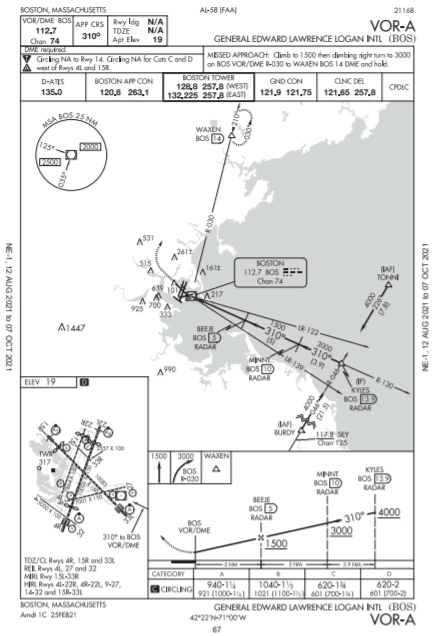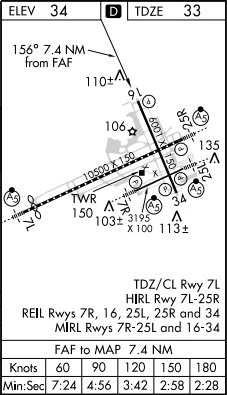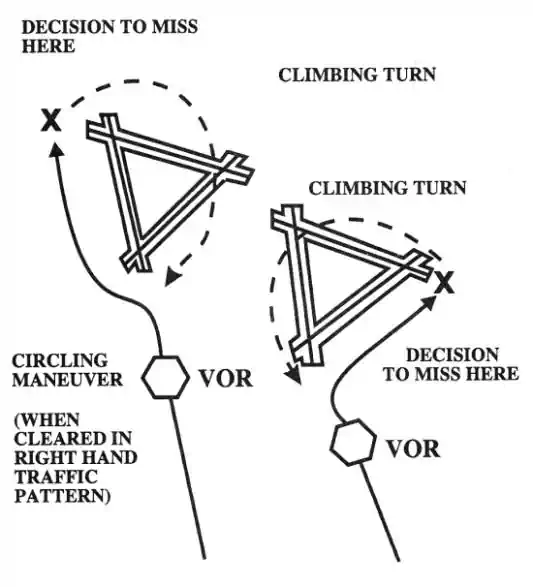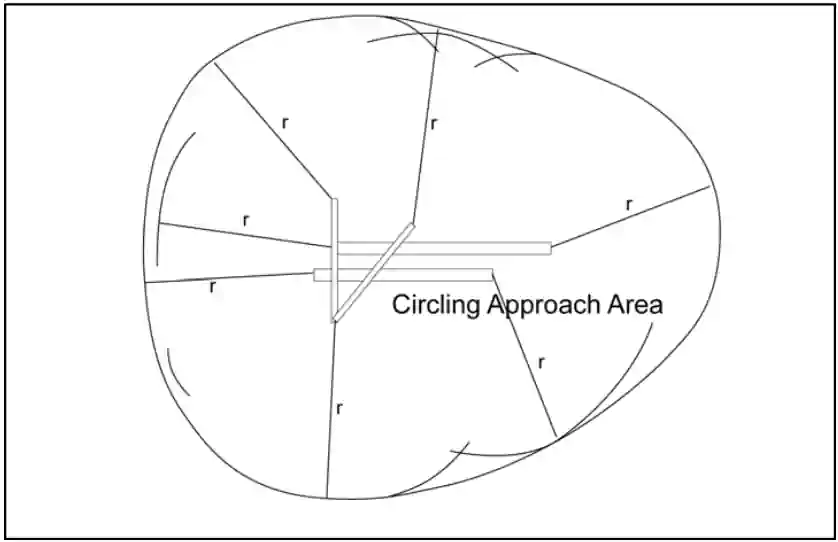Circling Approaches
Circling approaches are instrument approaches not flown to a specific runway, requiring a circling maneuver to land.
Introduction to Circling Approaches
- The Federal Aviation Administration establishes circling-only approaches to give pilots additional instrument approach options, either due to weather or equipment limitations.
- Circling approaches are depicted similarly to other instrument approaches, containing circling minima only.
- Instrument approach plates will publish circling minimums where the maneuver is permitted.
- As a result, circling approach minimums require unique considerations.
- Regardless of whether flying a straight-in or circling-only approach, a circling maneuver is always required.
- Circling approaches are potentially dangerous maneuvers requiring a lot of situational awareness.
- You will be low, you will be slow, and the weather may be bad.
- You may have little time, depending on the weather minimums, to orient yourself.
- With a circling approach clearance, pilots execute the circling approach/maneuver to landing.
- With circling approaches, unique missed approach scenarios warrant special consideration.
- Think you've got a solid understanding of circling approaches? Don't miss the circling approaches quiz below and the topic summary.
Circling Approach Purpose
- Circling-only approaches are not for any specific runway; they require a circle to maneuver in the visual segment to land.
- There are no Federal Aviation Regulations (FARs) specific to the circling maneuver.
- According to the Instrument Procedures Handbook, the FAA publishes circling-only approaches when:
- The final approach course is not within 30° of the runway heading.
- The descent gradient is greater than 400 feet per nautical mile from the final approach fix to the threshold, or;
- When the airfield layout does not clearly define the runways.
- The FAA labels circling-only approach plates with the Navigation Aid (NAVAID) and a letter (i.e., VOR-A). [Figure 1]
- Airports with more than one circling-only approach will increase the letter designation (i.e., VOR-A, VOR-B, etc.).
- Fundamentally, pilots fly circling-only approaches the same way they fly all other approaches.
Circling Approach Depiction
- Instrument approach plates will publish circling minimums where the maneuver is permitted.
- Circling minimums are published at the bottom of the plate with the straight-in minimums.
- In the case of a straight-in approach where circling is permitted, straight-in and circling minimums will be published. [Figure 2]
- In the case of an ILS where circling is permitted, circling minimums are published, but the missed approach point is at the published missed approach point, not where the glide slope intercepts the circling minimums.
- In the case of a circling-only approach, the approach chart will publish only circling minimums (no straight-in minimums). [Figure 3]
- Where applicable, the pilot briefing and procedures notes section of the instrument approach plate publishes special instructions for circling. [Figure 4]
- To aid the pilot, the airport diagram on the instrument approach plate will have an arrow showing aircraft orientation to the airport when approaching the runway. [Figure 5]
Circling Approach Minimums
- Any time pilots perform a circling maneuver, regardless of whether the approach is straight-in or circling-only, circling minimums apply.
- Circling minimums are higher than other minimums because the pilot is conducting a visual approach segment.
- Published minimums will provide a 300' obstacle clearance when pilots remain within the appropriate area of protection.
- Remember when you fly the approach, if you intend to circle to, descend to the circling Minimum Descent Altitude (MDA), not the straight-in MDAs (circling is typically higher than straight-in minimums).
- If no circling minimums are published, do not execute a circle to land. However, if authorized by Air Traffic Control (ATC), basic Visual Flight Rules (1000-3) are required.
- Pilots must stay at or above the circling MDA altitude until they are continuously in a position to descend and land on the intended runway using normal maneuvers.
- Usually, being in a position to descend and land will be just inside the 180/abeam, for most circling minimums would have you low on downwind.
Circling Maneuver
- Pilots fly circling maneuvers in the visual segment of the instrument approach.
- Depending on the category, aircraft circle within a specified proximity from the airport to land on the desired runway.
- The circling maneuver is not part of an instrument approach; it is the follow-on action to completing a circling approach.
- Circling approaches are one of the most challenging flight maneuvers conducted in the National Airspace System, especially for pilots of Category (CAT) C and CAT D turbine-powered transport category airplanes. These maneuvers are performed at low altitude, both day and night, often with precipitation present, which affects visibility, depth perception, and the ability to assess the descent profile to the landing runway.
- Pilots must maintain a specified radius based on aircraft category when circling to land.
- If GPS distance is not available or desired, a good visual cue is to use the runway (a known distance) as a ruler.
- There are no restrictions on passing over the airport or other runways. [Figure 6]
Circling Approach Clearance
- Once under approach control, you are ready to put in your request.
- Pilot: "[Agency], [Callsign], [Location], [Information], request."
- Example: "Daytona Approach, Cessna One Seven Two Seven Victor, 10 miles to the west with information Charlie, request."
- ATC will have you "stand by" or tell you to "send your request."
- Pilot: "[Callsign], request [Approach]."
- Example: "One Seven Two Seven Victor requests LOC 7L, circle runway 16."
- ATC will inform you of what you requested or provide modified instructions.
- Expect to switch to the tower frequency when approaching the VFR traffic pattern to keep everyone on the same frequency.
- Once under tower control, reiterate the approach request to ensure they are aware of your intentions.
- Pilot: "[Tower], [Callsign], [Location], on the [Approach], request circle to land [Runway]."
- Example: "Daytona Tower, Cessna One Seven Two Seven Victor, 3 miles to the west on the LOC 7L approach, request circle to land runway 16."
- ATC will either approve you or, if unable, request you continue on your current approach for the straight-in.
- ATC: "Cleared for [Approach], circle to land [Runway]."
- Example: "Cleared for the LOC runway 7L approach, circle north to land runway 16."
- If you forget, or you think you've heard contrary to the instructions you were expecting, read back for an added idiot check.
- Pilot: "Understand circling North?"
Circling Maneuver Procedure
WARNING:
All procedures are GENERALIZED.
Always fly per Pilot Operating Handbook procedures,
observing any relevant Standard Operating Procedures (SOPs).
- Commence the report, start the timer as necessary.
- Maneuver on the shortest path to the base or downwind leg, as appropriate, considering existing weather conditions.
- Circling may be made in conjunction with other flight operations at the airport.
- Plan to use standard left turns to circle to land, unless ATC dictates otherwise.
- Remain within the circling visibility minima during the circling approach.
- While there is no restriction on passing over the airport or other runways, expect restrictions during training operations.
- Remain at circling minimums until continuously in a position from which a normal descent rate to a landing on the intended runway using normal maneuvering.
- When descending from circling minimums:
- Callout, "Runway in Sight, Landing."
- Set the power to approach the speed..
- Complete a GUMP (Gas, Undercarriage, Mixture, Prop) check.
- When appropriate, at or below VFE, set the flaps.
- Complete the appropriate landing procedure.
Missed Approach Considerations
- Suppose visual reference with any identifiable part of the airport is lost while circling to land from an Instrument Approach Procedure. In that case, pilots must execute a missed approach (published or dictated by ATC).
- Maintain distance limitations that are dependent on aircraft class. [Figure 7/8]
- Always make the initial climbing turn toward the landing runway and continue the turn until established on the missed approach course. [Figure 6/9]
Circling Approach Case Studies
- National Transportation Safety Board Identification: ANC07FA073:
- The NTSB determines the probable cause(s) of this accident to be: The pilot's failure to maintain altitude/distance from obstacles during an Instrument Flight Rules circling approach, and his inability to follow the instrument approach procedure. Contributing to the accident were clouds.
- National Transportation Safety Board Identification: NYC07FA130:
- The NTSB determines the probable cause(s) of this accident to be: The pilot's failure to maintain airspeed, which resulted in an inadvertent stall and subsequent impact with terrain.
- National Transportation Safety Board Identification: DFW07FA067:
- The NTSB determines the probable cause(s) of this accident to be: The pilot's failure to maintain clearance with terrain. Contributing factors were drizzle/mist and weather conditions below the approach/landing minimums.
- National Transportation Safety Board Identification: ATL07FA013:
- The NTSB determines the probable cause(s) of this accident to be: The pilot's failure to maintain airspeed while maneuvering with a low ceiling in instrument flight conditions, resulting in an inadvertent stall and collision with trees on the ground. Factors in the accident were the pilot's failure to follow the published missed approach procedures and the airplane's checklist procedures for a balked landing.
- National Transportation Safety Board Identification: DFW06LA073:
- The NTSB determines the probable cause(s) of this accident to be: The pilot's loss of control while on approach to the runway. Contributing factors were the downdraft and the lack of suitable terrain for the off-airport landing.
Circling Approaches Knowledge Quiz
Circling Approaches Conclusion
- Circling approaches are helpful tools for executing an approach that is well aligned with your route of flight to circle (almost in the traffic pattern) rather than fly past an airport for a straight-in.
- Circling approaches and circling maneuvers are terms that often get used interchangeably.
- Circling approaches should refer to circling-only approaches (i.e., VOR-A). In contrast, the circling maneuver should refer to circling to a runway other than the runway named by an instrument approach.
- Circling approaches are challenging maneuvers, often conducted at low altitudes, where precipitation affects visibility, depth perception, and the ability to assess the descent profile to the landing runway.
- Circling approaches are typically conducted to runways without the aid of electronic navigation systems, supporting the descent from the Circling Minimums Decision Altitude (CMDA) to the runway.
- Pilots must use sound judgment, possess an in-depth knowledge of their capabilities, and fully understand their aircraft's performance to determine the exact circling maneuver. Take into account weather, unique airport design, aircraft position, altitude, and airspeed.
- When circling, maneuver the shortest path to join the pattern, on the base or downwind leg, as appropriate, considering existing weather conditions.
- Circling maneuvers may be made while VFR or other flight operations are in progress.
- If in Class G airspace, make all turns of that airplane to the left (with the intent to follow the flow of traffic) unless the airport displays approved light signals or visual markings indicating right turns, in which case the pilot must make all turns to the right.
- If in Class E or any towered airspace, circling instructions may be provided by ATC.
- In their absence, follow the same requirements as if in class G airspace.
- You are never required to fly the MDA if out of the clouds and should fly as close to the published traffic pattern parameters as possible.
- And while circling, don't descend below MDA until the runway environment is in sight.
- See Advisory Circular 90-66C, Non-Towered Airport Flight Operations and the 2014 Krug legal interpretation letter for more information.
- At airports without a control tower, it may be desirable to fly over the airport to observe wind and turn indicators. Other traffic may be on the runway or flying in the vicinity of the airport.
- Unsafe landings follow unstabilized approaches; however, requesting an option to perform a lap in the pattern to a complete stop provides options.
- While circling approaches exist as a tool, given their complexity at low altitude in potentially low weather conditions, consider them a secondary option to conducting a straight-in approach, unless for training or out of necessity.
- To learn more about instrument procedures, be sure to check out the Instrument Procedures Handbook online or in paperback.
- Pilots can visit the FAA's Instrument Flight Procedures Information Gateway to review and submit questions about how and why certain procedures are structured as they are.
- Still looking for something? Continue searching:










